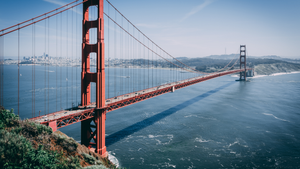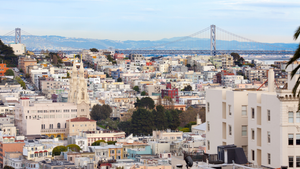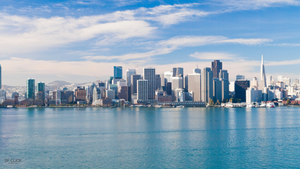
San Francisco's Iconic Transamerica Pyramid
The Transamerica Pyramid, an iconic 48-story modernist skyscraper in San Francisco's Financial District, has been a defining feature of the city's skyline since its completion in 1972. As reported by NBC Bay Area, this 52-year-old architectural marvel is currently undergoing significant upgrades and improvements, aimed at revitalizing its presence for the next half-century.
Architect William Pereira's Vision
William Pereira, the architect behind the Transamerica Pyramid, was known for his futuristic and innovative designs that helped shape mid-20th century American architecture. Pereira's vision for the Transamerica Pyramid was initially met with criticism but eventually became accepted as a creative and iconic symbol of San Francisco. The building's unique pyramidal shape was a departure from traditional skyscraper designs, reflecting Pereira's penchant for geometric forms and his ability to envision bold, forward-thinking structures. His design philosophy often incorporated elements such as pre-cast concrete facades, reflective glass, and integration with water features, although the latter was not applicable to the urban setting of the Transamerica Pyramid. Pereira's work on this project exemplified his talent for creating landmark buildings that stood out in their environments while still serving functional purposes.
The Pyramid's Role in Pop Culture
The Transamerica Pyramid has become a cultural icon, deeply embedded in popular media and art. Its distinctive silhouette is frequently featured in films, television shows, and photographs, serving as an instant visual shorthand for San Francisco. The building's unique shape has inspired artists and filmmakers, making it a staple in representations of the city's skyline. Its prominence in media has contributed significantly to its global recognition, cementing its status as a symbol of San Francisco's innovative spirit and architectural excellence. The pyramid's image is so closely associated with the city that it has become part of Transamerica Corporation's logo, despite no longer being the company's headquarters. This widespread cultural presence has helped transform public perception of the building from initial controversy to beloved landmark, illustrating how architectural icons can shape and reflect a city's identity in popular culture.
The 2020 Renovation and Norman Foster's Redesign
In 2020, real estate investor Michael Shvo purchased the Transamerica Pyramid for $650 million, initiating a $400 million renovation project led by renowned architect Norman Foster and his firm, Foster + Partners. The ambitious redesign aims to modernize the iconic structure while preserving its distinctive character. Foster's plan includes expanding open spaces at the building's base, renovating interiors and exteriors, and revitalizing the surrounding Redwood Park. The project will introduce new amenities such as public shopping areas on the ground floor, a penthouse club for building occupants on the 48th floor, and luxury office spaces. Additionally, the renovation extends to adjacent buildings, creating a cohesive complex that aims to reinvigorate the neighborhood and attract new tenants. Construction began in 2022, with the first phase expected to open in 2023, marking a significant step in the building's evolution and its role in San Francisco's urban landscape.
Appearances in Film and TV
The Transamerica Pyramid has become a prominent fixture in numerous films and television shows, solidifying its status as an iconic symbol of San Francisco. Its distinctive shape and prominent position in the city's skyline make it an instantly recognizable landmark for audiences worldwide.
In the realm of cinema, the pyramid has been featured in several notable films. It appeared in the 1978 remake of the science fiction movie "Invasion of the Body Snatchers," where its futuristic design complemented the film's eerie atmosphere. The building's presence in this cult classic helped cement its association with San Francisco in the public imagination.
The pyramid's appearances are not limited to science fiction. It has been featured in various genres, from action thrillers to romantic comedies. Its inclusion in these films often serves as a visual shorthand, immediately establishing San Francisco as the setting without the need for explicit dialogue or exposition.
Television shows set in San Francisco frequently incorporate the Transamerica Pyramid into their establishing shots or background scenes. This consistent presence in both film and television has contributed to the building's status as a defining symbol of the city, on par with other famous landmarks like the Golden Gate Bridge.
The pyramid's role in popular media extends beyond mere background imagery. In some cases, it has been integral to plot points or used symbolically to represent themes of innovation, progress, or the unique character of San Francisco. Its distinctive silhouette has become so closely associated with the city that it often appears in stylized representations of San Francisco in animated films and television shows as well.
The Transamerica Pyramid's frequent appearances in film and television have not only reinforced its cultural significance but have also contributed to its global recognition. For many viewers around the world, the pyramid has become synonymous with San Francisco, serving as a visual anchor that immediately evokes the city's atmosphere and identity.
Related Posts

Golden Gate Bridge
The Golden Gate Bridge, an iconic suspension bridge spanning the Golden Gate strait in San Francisco, California, is renowned as one of the most photographed and internationally recognized symbols of the city.

North Beach Little Italy
North Beach, also affectionately known as "Little Italy," offers a delightful blend of history, culture, and culinary adventures.

San Francisco Attractions
San Francisco, a vibrant city known for its iconic landmarks and diverse attractions, has inspired numerous YouTube videos showcasing its beauty and charm.